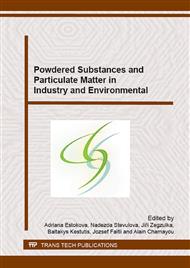p.188
p.197
p.205
p.213
p.221
p.228
p.234
p.240
p.246
Activated Zeolite and Magnesite as Potential Reactive Materials for Passive Acidic Groundwater Treatment Technology
Abstract:
Permeable reactive barriers (PRBs) are passive, in-situ remediation systems that comprise the filtration of a contaminated groundwater through a reactive media able to degrade, adsorb or precipitate the pollutants. Selection of the reactive media depends on the nature of the contamination. While the majority of PRBs are used to treat groundwater contaminated with chlorinated volatile organic compounds or acid mine drainage, the present study is focused on heavy metals, namely Fe, Al, Cu, Ni, Zn, Mn and As. To remove such inorganic pollutants, four methodologies are usually implemented: a) redox reaction, b) adsorption and ion exchange, c) biological treatment (e.g. metal sulphides precipitation) and d) pH control and precipitation. The present paper deals with the last methodology in which an adjustment of pH by alkalinity-generating materials leads to the precipitation of metal hydroxides and the decrease in the concentration of dissolved species. As the solubility of metals depends on their valence, redox-potential, concentrations and kinetics of reaction, the target pH varies with respect to the considered metal. A pH of about 10 allows the precipitation of hydroxides of divalent ions (zinc, manganese, copper, lead, nickel, cobalt and cadmium), while a pH of around 6-7 is adapted to trivalent ions (iron, aluminium and chromium). However, the accumulation of precipitates in the pore spaces can cause clogging of the pores, hence decrease the porosity and hydraulic conductivity of the reactive media and alter its efficiency. To validate this assumption, the neutralizing ability of alkaline materials such as activated zeolite and magnesite were examined in a test column by monitoring the resultant pH with attention to impact of precipitates on the hydraulic properties of reactive materials. Based on the test results, both materialls are considered suitable to remove the groundwater contaminants with high efficiency (up to 99%) and suitable grain size to encourage flow through the PRB.
Info:
Periodical:
Pages:
221-227
Citation:
Online since:
October 2015
Authors:
Keywords:
Price:
Сopyright:
© 2016 Trans Tech Publications Ltd. All Rights Reserved
Share:
Citation:


